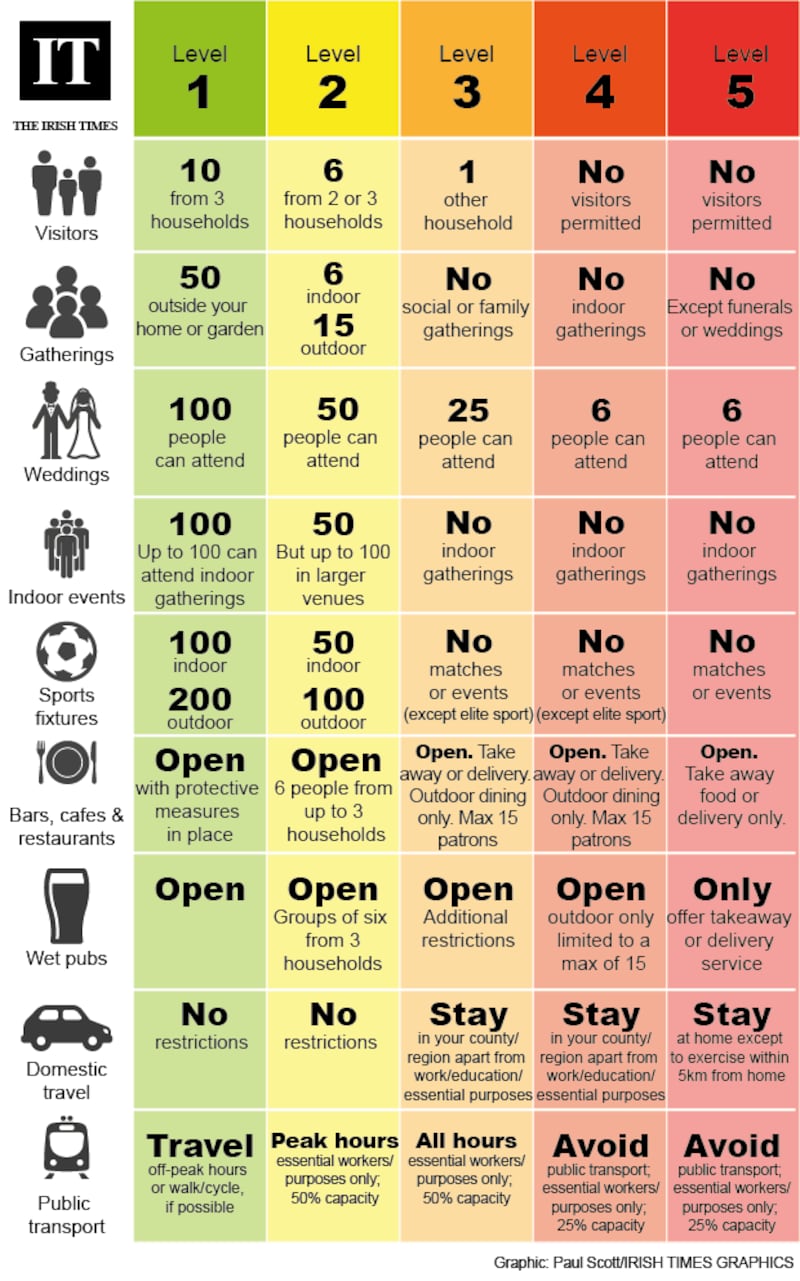Dublin is a "disease reservoir" for Covid-19 which threatens the whole country, the acting chief medical officer Dr Ronan Glynn has warned.
Dr Glynn suggested that if left unchecked cases could rise in the capital to up to 300 per day by the end of September.
Currently cases are rising by 4 per cent per day and the R0 reproduction number at 1.4 signals the spread of the disease is accelerating.
In his advice to Government last week, Dr Glynn said Covid-19 infections in Dublin have the “potential to transmit widely and quickly both within Dublin and to other areas of the country”.
However, he stopped short of suggesting that Dublin should move to Level 3 of the Government’s five-level Living with Covid-19 plan as has been suggested by some members of the Cabinet. The county was put at Level 2 yesterday but with some additional restrictions added on.
He said this was because most cases in Dublin were concentrated in young people, meaning the rates of hospitalisations are low and deaths have stabilised.
However, Dr Glynn, on behalf of the National Public Health Emergency Team (NPHET), did advise that additional measures were essential to contain transmission and bring the disease under control in Dublin.
‘Stabilisation’
Dr Glynn suggested that so-called “wet pubs” should not open on September 21st and should only open when there has been “at least two weeks of stabilisation in the disease trajectory”. He recommended that Dublin should not be allowed to have up to 200 people at a match, depending on the size of the venue, unlike the rest of the country, which is at level 2.

In its roadmap published on Tuesday, the Government adopted all the measures as outlined by NPHET including a recommendation, though it is not mandatory, that people living in Dublin should not travel outside the county.
Meanwhile, the chair of NPHET's epidemiological modelling advisory group, Prof Philip Nolan, predicted cases of Covid-19 would rise to between 1,400 and 3,500 a day by the end of next month if the present trajectory of the disease continues.
He said Covid-19 infections are rising at a rate of between 4 and 6 per cent per day nationwide and will double every 12 to 18 days unless case numbers are brought under control.
Infections were overwhelmingly clustered in younger people in August, hence the low rates of hospitalisations and death, but numbers in the more vulnerable population over the age of 65 have risen recently.
Older people
People aged over-65 account for 13 per cent of the population and 10 per cent of the cases confirmed in the last 14 days were in this cohort, Prof Nolan said. Over-65s have been much more likely to be hospitalised or to die as a result of Covid-19.
For those under-65, 11 per cent were hospitalised, 2 per cent admitted to intensive care units (ICUs) and 0.8 per cent died; for those over the age of 65, 54 per cent were admitted to hospital, 6 per cent were admitted to ICU and 20 per cent died.
Prof Nolan predicted that at present rates, if 10 per cent of new cases are 65 or older, we can expect 45 hospitalisations, eight admissions to intensive care, and eight deaths per 1,000 cases of confirmed Covid-19.
“We had 1,300 cases last week. We cannot let this number grow further,” he warned on a long Twitter thread.
“We need to reduce the number of new cases to a much lower level, not just to prevent avoidable illness and death, but to reduce the risk of uncontrolled spread in our community and major outbreaks in vulnerable settings. We owe it to each other to suppress the virus.”
He said a lot of commentary in relation to Covid-19 underestimated the effectiveness of surveillance in April and “the seriousness of the situation now”.
The HSE was carrying out between 3,000 and 4,000 tests per day in April with a positivity rate of more than 20 per cent leading to a peak of almost 1,000 recorded infections in one day.
Now, the HSE is doing close to 12,000 test per day now with some 2 per cent of people testing positive, many of whom have mild or no symptoms.
“Mild and asymptomatic cases matter. If not detected and isolated, they will transmit the virus to others, fuelling exponential growth in infections,” he said.
Clusters
The latest figures from the Health Protection Surveillance Centre (HPSC) state that there were 158 clusters of Covid-19 in the week between September 5th and 12th. The largest number of those, 61, were in private homes, followed by workplaces at 22.
Of the clusters in workplaces, six were in food processing plants and three were in the construction industry.
There were 17 cases associated with community transmission where the source of the virus is not known and just 13 in schools, which all opened last week.
There were seven new clusters associated with residential institutions, four new clusters associated with nursing homes and three with hopsital settings.
There were three clusters associated with restaurants and none with pubs. Three clusters were also associated with travel.







